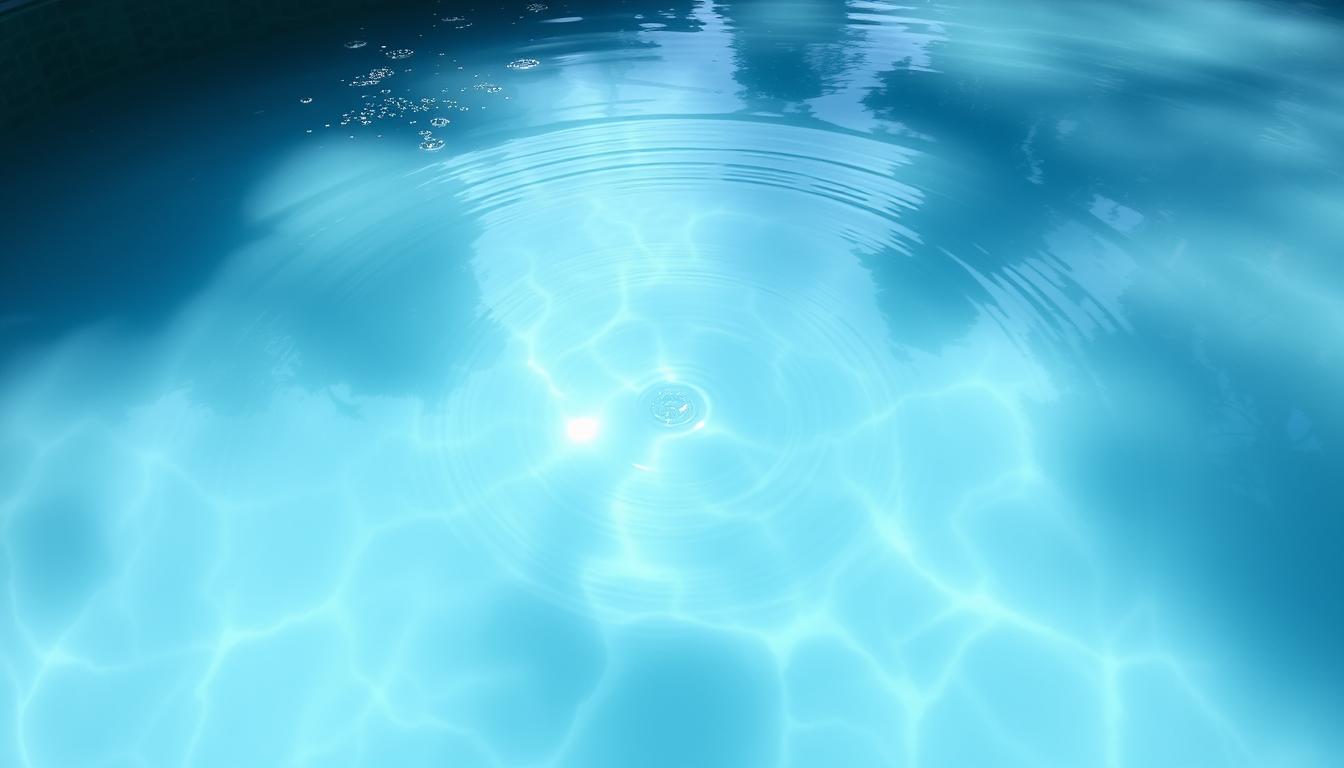
Pool shock may not work if the pH is above 7.8 or 8.2. This fact shows why proper water balance matters. Shocking is key for pool care, but it can cause cloudy water.
Clear pool water is the goal. To achieve this, we must understand what causes cloudiness. We also need to know how to fix it.
Cloudy water after shock is common. It can happen due to unbalanced pH, high calcium hardness, or poor filtration. Environmental factors like debris can also play a role.
By tackling these issues, you can restore your pool’s sparkle. Soon, you’ll be able to enjoy a refreshing swim again. Let’s explore how to clear up your cloudy pool water.
Key Takeaways
- Maintain proper water balance, with pH levels between 7.4 and 7.6 and calcium hardness between 100-400 ppm.
- Ensure effective filtration and circulation by running the pool filter continuously and backwashing at least once a week.
- Use pool clarifiers or flocculants to help clear up cloudy water and remove small particles.
- Brush and vacuum the pool thoroughly to remove algae, debris, and other contaminants.
- Test and adjust water chemistry regularly, and shock the pool as needed to maintain optimal chlorine levels.
Understanding the Causes of Cloudy Pool Water After Shocking
Cloudy pool water after shocking can be frustrating. Several factors can cause this issue. These include imbalanced water chemistry, poor filtration, and environmental factors.
Identifying the root cause is key to fixing the problem. This helps restore pool clarity and ensures safe swimming.
Imbalanced pH Levels and Alkalinity
High pH levels can reduce chlorine’s effectiveness against bacteria. This can lead to chloramines, which make water cloudy. High pH is typically above 7.8.
High total alkalinity (TA) can cause pH instability. It can also lead to calcium scaling. Both issues can make pool water cloudier.
High Calcium Hardness
Elevated calcium hardness levels can cause persistent cloudiness. This usually happens when levels exceed 400 ppm. Excess calcium combines with carbonates, forming insoluble particles.
These particles create a hazy appearance. Balancing calcium hardness is crucial for clear water. It also prevents damage to pool surfaces and equipment.
Ineffective Filtration and Circulation
Good filtration and circulation are vital for clear pool water. Poor filtration lets small particles accumulate, causing cloudiness. Bad circulation prevents even chemical distribution.
It also allows debris to settle in certain areas. Regular filter cleaning and optimal water flow are essential. These practices combat cloudy water and promote sanitization.
According to industry experts, improper filtration, insufficient water circulation or flow rate, and poor water chemistry are common causes of cloudy water.
Environmental Factors and Debris
Wind, rain, and nearby plants can introduce particles into the pool. These include leaves, twigs, pollen, and dust. Heavy rain can dilute chlorine and add contaminants.
Swimmers also affect water clarity. They introduce sweat and oils that deplete disinfectants. This can promote algae and bacteria growth.
| Cause | Effect | Solution |
|---|---|---|
| High pH levels | Reduced chlorine effectiveness, chloramine formation | Test and adjust pH levels regularly |
| High calcium hardness | Calcium scaling, persistent cloudiness | Balance calcium hardness levels |
| Ineffective filtration | Accumulation of small particles, debris | Clean pool filter, ensure optimal water flow |
| Environmental factors | Introduction of contaminants, dilution of chlorine | Use pool covers, skim surface regularly |
Understanding these causes helps us tackle cloudy pool water. Regular testing and adjusting water chemistry are key. Proper filtration and circulation are also important.
With the right knowledge and practices, we can maintain a clear pool. This ensures a sparkling, inviting swim all season long.
Steps to Clear Up a Cloudy Pool After Shocking
Got a cloudy pool after shocking? Don’t worry! You can fix it with a few easy steps. We’ll show you how to restore your pool’s crystal-clear look.
Test and Adjust Water Chemistry
Start by testing your pool’s water chemistry. Use a good testing kit to check pH, alkalinity, and calcium hardness levels. Aim for a pH between 7.4 and 7.6.
Keep alkalinity between 100 and 150 ppm. Calcium hardness should be 200 to 400 ppm. If levels are off, use the right chemicals to fix them.
Good water chemistry helps with filtration and sanitization. This can clear up cloudiness caused by shocking your pool.
Run the Pool Filter Continuously
Run your pool filter non-stop for at least 24 hours after shocking. This removes small particles and debris that make water cloudy. Make sure your filter is clean and working well.
If needed, backwash or clean the filter to improve its performance. Constant filtering spreads the shock treatment evenly, clearing cloudy water faster.
Use Pool Clarifiers or Flocculants
If your pool is still cloudy, try pool clarifiers or flocculants. These products clump small particles together, making them easier to filter out. Clarifiers are added directly to the water.
Flocculants gather debris into big clumps that sink to the pool bottom. You can then vacuum these out easily. Follow the product instructions carefully for best results.
Brush and Vacuum the Pool
Physically removing debris helps clear cloudy water too. Use a pool brush to scrub the walls and floor. Focus on areas with visible algae or stains.
After brushing, vacuum the pool thoroughly to remove loosened debris. For best results, vacuum to waste. This sends water out of the pool instead of through the filter.
Regular brushing and vacuuming, plus good water care, will keep your pool clear after shocking. Your pool will stay inviting and ready for fun!







